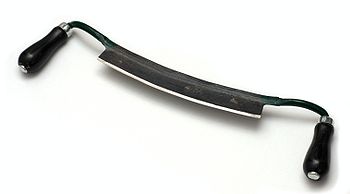- Drawknife
-
A drawknife is a traditional woodworking hand tool used to shape wood by removing shavings. It consists of a blade with a handle at each end. The blade is much longer (along the cutting edge) than it is deep (from cutting edge to back edge). It is pulled or "drawn" (hence the name) toward the user.
The drawknife in the illustration has a blade 23 cm long; much shorter drawknives are also made. The blade is sharpened to a chisel bevel. Traditionally, it is a rounded, smooth bezel. The handles can be below the level of the blade (as in the illustration) or at the same level[1].
Contents
Purpose
A drawknife is commonly used to remove large slices of wood for flat faceted work, to debark trees, or to create roughly rounded or cylindrical billets for further work on a lathe, or it can shave like a spokeshave plane, where finer finishing is less of concern than a rapid result. The thin blade lends itself to create complex concave or convex curves.
Unlike a spokeshave it does not have a closed mouth to control chip formation, and so lacks the spokeshave's superior cutting and shaving precision [1][2].
They are also a vital piece of equipment in hand-made Cricket bats, being used to shape the curve of the bat.
Blade hardening
A blade found to be too soft as it rapidly loses its cutting edge can be hardened. The blade is heated to red hot (as observed in an indoor room in average Autumn–Spring daylight (not bright)) and immediately quenched rapidly in water, until completely cool to safely handle with hands.[3]
Operation
The drawknife ideally is used when the operator is seated position astride the traditional shave horse, which safely grips the working stock, and they can also use their legs for additional pulling power. The ideal working stock has the grain of the wood running parallel to the shavehorse, and perpendicular to the blade of the drawknife—so that the drawknife shaves away the entire wood fibre, not cut against it.[1] It is best not pulled with blade perfectly perpendicular to the wood stock, but pulled slightly upward toward them in a skewed (blade at a slight diagonal) or slithering fashion, aiming not to take off as much wood as possible, but gradually "shave" the work: The operator gently levers the blade to "bite" into the wood and then controls the depth of the cut by raising or lowering the handles as he pulls the drawknife.[1][4]
Straight cuts
One works from the centre of the piece to the end, not the entire length all at once. The operator then reverses the piece in the shavehorse or vice and works from near centre to trim the "fatter" end to match the centre and just finished original "skinny" end. Final work can be done by spokeshave, sanding block or lathe.[4]
- When operated conventionally, that is blade bevel-side upward the drawknife takes deeper cuts and some novices may find it has a tendency to "dive" (cut unintentionally deep).
- When operated bevel-side down there is the advantage of removing less stock, but the blade dulls more rapidly, requiring frequent honing.
Convex
The operator applies little leverage from centre and most leverage, so the blade "bites" deeper, thus removing more wood as they approach the end grain[4].
Concave
The operator applies minimal, then most, then least force on the handles from centre toward the end grain. The work stock is reversed and same method repeated this time commencing a tiny distance away from centre so as to leave a coarse raised section. The coarse raised section where the two concave curves meet can be finished with a rasp, file, spokeshave or other tool.[5]
Splitting
For very rapid and rough removal of stock, blade is drawn toward user and rapidly levered into the wood to make as deep a cut as possible. The operator immediately stops pulling, and uses the drawknife blade to lever upward so as to "flick" the splinter or splice out of the worked piece. This technique is advanced and may damage the worked piece and drawknife blade if due care is not observed.[4]
Traditionally, the waste shavings are used for basket-weaving, which are particularly durable or for kindling. The shavings make excellent compost and plant bed material.
Large drawknives can be used to dress logs, and small sizes for carving and shaving. A common use of a drawknife is to create a roughly cylindrical billet of wood for turning on a pole lathe.
Fifty million tent-pegs were manufactured in the UK throughout the Second World War via drawknife method, with as little as 18 draws completing a piece from tree cut log, to peg.[6]
References
- ^ a b c d American Woodworker May–Jun 1990 , No 14 ISSN 1074-9152 72 pages pp:39
- ^ Roy Underhill The Woodwright's Shop: a Practical Guide to Traditional Woodcraft, University of North Carolina Press: 1981, ISBN 0807840823: 202 pages, pp 39-40 [1]
- ^ Popular Science March 1942: Midget Drawknife Vol. 140, No. 3 ISSN 0161-7370, Bonnier Corporation:1942 Please note that the foregoing is not really practical with a drawknife with (wooden) handles fitted as heat conducted to the tangs in the handles will at the very least char them! Note also that the quench-hardened blade, while very hard, will be brittle and must be tempered to reduce the brittleness. [2]
- ^ a b c d American Woodworker Dec 1995: No.49, New Track Media, ISSN: 1074-9152 pp: 43–45.[3]
- ^ American Woodworker Dec 1995: No.49, New Track Media, ISSN: 10749152, pp: 43–45.[4]
- ^ Drew Langsner, Green woodworking: handcrafting wood from log to finished product, Rodale Press: 1987, ISBN 0878576886: 304 pages
External links
Categories:- Green woodworking tools
- Green woodworking
- Woodworking hand tools
Wikimedia Foundation. 2010.

